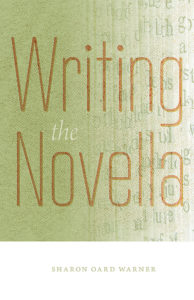 Review by Lisa C. Taylor
Review by Lisa C. Taylor
This new resource book on the novella form opens with examples of familiar novellas like Ethan Frome and The House on Mango Street. Divided into sections that will be helpful for any fiction writer, the book provides practical step-by-step information for writing in this form. Each chapter offers a journaling section with detailed practice prompts. The author also advises aspiring writers to write fifteen minutes a day without stopping.
In the first section, the author both defines fiction and provides ways to approach writing a novella.
“As a genre, as a way of life, writing fiction is primarily exploratory; it is an approach to understanding the world.” (27)
And later on the same page:
“Every writing project is a blind date with your unconscious and all such encounters begin with what the poet Richard Hugo called a trigger.” (27)
She describes a trigger as “a pairing of incongruities.” I love this description because it gets to the core of what makes fiction work: forces working against each other, represented by characters, or a situation that alters the world or perception of a protagonist. Triggers are subjective. She also believes in finding a “touchstone” or a role model novella to learn from. For the purpose of this book, she uses Ethan Frome by Edith Wharton, Fahrenheit 451 by Ray Bradbury and The House on Mango Street by Sandra Cisneros. All of these books fit the description of a novella as defined by John Gardner in his much-heralded book, The Art of Fiction: Notes on Craft for Young Writers. Gardner defines a novella as 30,000- 50,000 words, although some novellas can be up to 60,000 words. Are there other characteristics of a novella? Sharon Oard Warner thinks so. In economy of language, novellas generally resemble a screenplay more than a novel, and they commonly have a theme or focus.
In the third section of the book, she discusses the role of character and plot in fiction.
“What compels you to finish a book you start? What keeps you reading to the very end? Yep, That’s what I thought. It’s not just an interesting character, now, is it?” (39)
She doesn’t advocate plotting an entire novella nor does she take a “seat-of-the-pants” approach. Writers dwell in uncertainty and sometimes a story takes an unexpected turn. This is why she encourages intuition over reason in fiction writing. She compares fiction writing to archaeology—an excavation. The writer must decide why he or she is compelled to dig in just that spot. Characters are important because it is the writer who decides exactly how the character will respond in particular circumstances. Her prompts at the end of the chapter provide ways for a writer to draw out character. Even if a few specific details figure into the story, knowing a character lends authenticity. For her own novels, she researched beekeeping, tarot, evangelical religion, and communes.
Identifying the protagonist and the situation is critical to a successful story. Stories drive cultures, help us to feel connected, and aid us in surviving this ever-complicated and stressful world. In The Old Man and the Sea by Ernest Hemingway, the sea is the antagonist.
She reiterates what other writers and teachers have taught: write in scenes. Scenes help to reveal character and advance plot. Readers will always find a scene more compelling than exposition. She posits that many readers rush through summaries to get to the next scene because it is in scene that emotion and action takes place.
“Convincing the audience of the realness of characters is one of the main objects of scenes.” (68)
As a handbook for aspiring novelists as well as short-story and novella writers, this book is a valuable addition to a writer’s toolbox. Although many of the concepts were familiar, and some are offered in other writing resource books, her specific attention to the novella and the journaling prompts makes this book unique. The resource list is impressive: presses that publish novellas, competitions for novellas (I was surprised to see so many), recommended novellas, and novellas included in short story collections. She also includes the “Proust Questionnaire” to help writers to develop a protagonist. She says, “a novella is along a single narrative arc, and its plot points occur at predictable intervals.” (171). Some writers strive to be unpredictable in unfolding a plot but with this shorter form, more direction may be useful. This book is a good starting point for writers who wish to try the novella form.
Sharon Oard Warner is a professor emerita of English and creative writing at the University of New Mexico. She is the author of several books, including Sophie’s House of Cards: A Novel From 1999 -2016, she founded and directed the Taos Summer Writers’ Conference, one of the largest such gatherings in the country. She continues to serve as Co-Chair for the D. H. Lawrence Ranch Initiatives. Her essays and articles have appeared in The AWP Chronicle, The Writer and other writing resource books and journals.
Writing the Novella by Sharon Oard Warner
University of New Mexico Press $19.95 paper
ISBN 978-0-8263-6255-1
Lisa C. Taylor is the author of four collections of poetry and two collections of short fiction, most recently, Impossibly Small Spaces (2018). She was awarded the Hugo House New Works Fiction Award in 2015. A new collection of her poetry will be published in May of 2022.
